Research Skills - Business Leadership and Responsibility Assignment
VerifiedAdded on 2023/06/08
|11
|3698
|209
Homework Assignment
AI Summary
This assignment delves into research skills, focusing on the research process, data collection methods, and data analysis techniques. It begins with an introduction to research, outlining the research process, key issues, and the rationale for choosing the research topic of business leadership and responsibility. The assignment differentiates between data, information, and knowledge, discussing their impact on a research proposal. It then explores data collection, differentiating between primary and secondary sources, justifying the relevance of secondary data, and explaining the process of data collection and challenges faced. The assignment analyzes and interprets data from academic sources, identifying uses of data to support or disprove claims. Furthermore, it examines the importance of data in marketing decision-making, techniques for measuring data quality, and the impact of information security, concluding with reflections on big data, and its pros and cons.
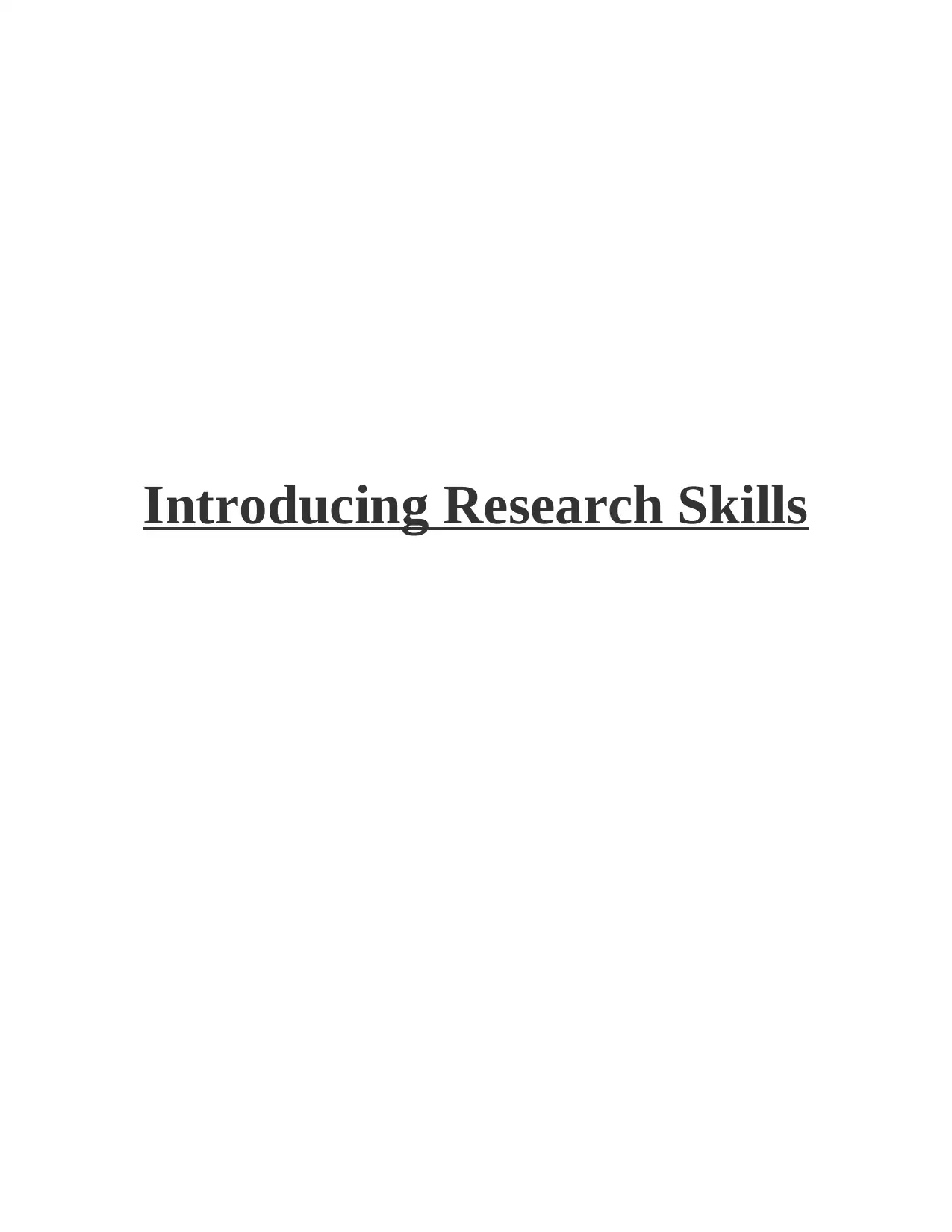
Introducing Research Skills
Paraphrase This Document
Need a fresh take? Get an instant paraphrase of this document with our AI Paraphraser
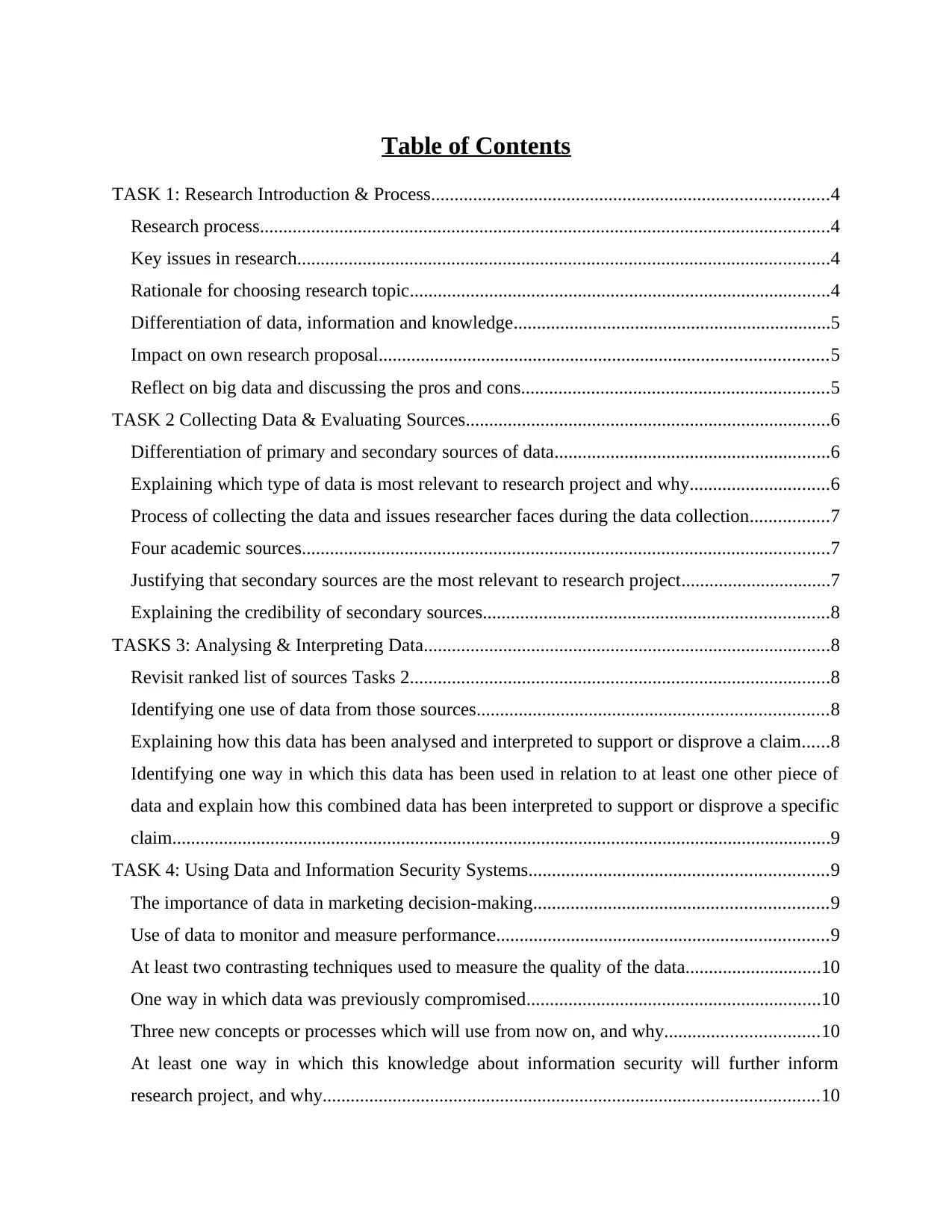
Table of Contents
TASK 1: Research Introduction & Process.....................................................................................4
Research process..........................................................................................................................4
Key issues in research..................................................................................................................4
Rationale for choosing research topic..........................................................................................4
Differentiation of data, information and knowledge....................................................................5
Impact on own research proposal................................................................................................5
Reflect on big data and discussing the pros and cons..................................................................5
TASK 2 Collecting Data & Evaluating Sources..............................................................................6
Differentiation of primary and secondary sources of data...........................................................6
Explaining which type of data is most relevant to research project and why..............................6
Process of collecting the data and issues researcher faces during the data collection.................7
Four academic sources.................................................................................................................7
Justifying that secondary sources are the most relevant to research project................................7
Explaining the credibility of secondary sources..........................................................................8
TASKS 3: Analysing & Interpreting Data.......................................................................................8
Revisit ranked list of sources Tasks 2..........................................................................................8
Identifying one use of data from those sources...........................................................................8
Explaining how this data has been analysed and interpreted to support or disprove a claim......8
Identifying one way in which this data has been used in relation to at least one other piece of
data and explain how this combined data has been interpreted to support or disprove a specific
claim.............................................................................................................................................9
TASK 4: Using Data and Information Security Systems................................................................9
The importance of data in marketing decision-making...............................................................9
Use of data to monitor and measure performance.......................................................................9
At least two contrasting techniques used to measure the quality of the data.............................10
One way in which data was previously compromised...............................................................10
Three new concepts or processes which will use from now on, and why.................................10
At least one way in which this knowledge about information security will further inform
research project, and why..........................................................................................................10
TASK 1: Research Introduction & Process.....................................................................................4
Research process..........................................................................................................................4
Key issues in research..................................................................................................................4
Rationale for choosing research topic..........................................................................................4
Differentiation of data, information and knowledge....................................................................5
Impact on own research proposal................................................................................................5
Reflect on big data and discussing the pros and cons..................................................................5
TASK 2 Collecting Data & Evaluating Sources..............................................................................6
Differentiation of primary and secondary sources of data...........................................................6
Explaining which type of data is most relevant to research project and why..............................6
Process of collecting the data and issues researcher faces during the data collection.................7
Four academic sources.................................................................................................................7
Justifying that secondary sources are the most relevant to research project................................7
Explaining the credibility of secondary sources..........................................................................8
TASKS 3: Analysing & Interpreting Data.......................................................................................8
Revisit ranked list of sources Tasks 2..........................................................................................8
Identifying one use of data from those sources...........................................................................8
Explaining how this data has been analysed and interpreted to support or disprove a claim......8
Identifying one way in which this data has been used in relation to at least one other piece of
data and explain how this combined data has been interpreted to support or disprove a specific
claim.............................................................................................................................................9
TASK 4: Using Data and Information Security Systems................................................................9
The importance of data in marketing decision-making...............................................................9
Use of data to monitor and measure performance.......................................................................9
At least two contrasting techniques used to measure the quality of the data.............................10
One way in which data was previously compromised...............................................................10
Three new concepts or processes which will use from now on, and why.................................10
At least one way in which this knowledge about information security will further inform
research project, and why..........................................................................................................10

REFERENCES................................................................................................................................1
⊘ This is a preview!⊘
Do you want full access?
Subscribe today to unlock all pages.

Trusted by 1+ million students worldwide
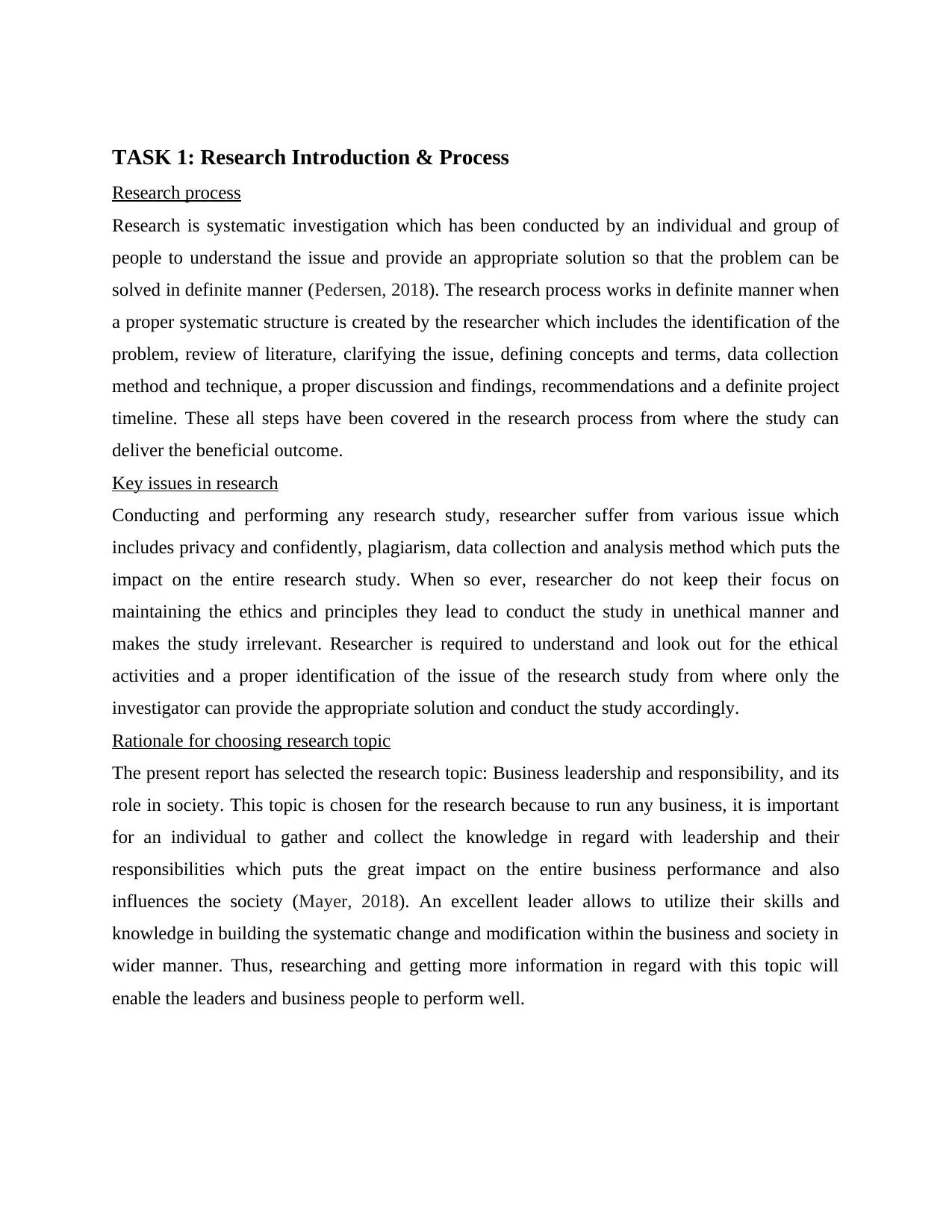
TASK 1: Research Introduction & Process
Research process
Research is systematic investigation which has been conducted by an individual and group of
people to understand the issue and provide an appropriate solution so that the problem can be
solved in definite manner (Pedersen, 2018). The research process works in definite manner when
a proper systematic structure is created by the researcher which includes the identification of the
problem, review of literature, clarifying the issue, defining concepts and terms, data collection
method and technique, a proper discussion and findings, recommendations and a definite project
timeline. These all steps have been covered in the research process from where the study can
deliver the beneficial outcome.
Key issues in research
Conducting and performing any research study, researcher suffer from various issue which
includes privacy and confidently, plagiarism, data collection and analysis method which puts the
impact on the entire research study. When so ever, researcher do not keep their focus on
maintaining the ethics and principles they lead to conduct the study in unethical manner and
makes the study irrelevant. Researcher is required to understand and look out for the ethical
activities and a proper identification of the issue of the research study from where only the
investigator can provide the appropriate solution and conduct the study accordingly.
Rationale for choosing research topic
The present report has selected the research topic: Business leadership and responsibility, and its
role in society. This topic is chosen for the research because to run any business, it is important
for an individual to gather and collect the knowledge in regard with leadership and their
responsibilities which puts the great impact on the entire business performance and also
influences the society (Mayer, 2018). An excellent leader allows to utilize their skills and
knowledge in building the systematic change and modification within the business and society in
wider manner. Thus, researching and getting more information in regard with this topic will
enable the leaders and business people to perform well.
Research process
Research is systematic investigation which has been conducted by an individual and group of
people to understand the issue and provide an appropriate solution so that the problem can be
solved in definite manner (Pedersen, 2018). The research process works in definite manner when
a proper systematic structure is created by the researcher which includes the identification of the
problem, review of literature, clarifying the issue, defining concepts and terms, data collection
method and technique, a proper discussion and findings, recommendations and a definite project
timeline. These all steps have been covered in the research process from where the study can
deliver the beneficial outcome.
Key issues in research
Conducting and performing any research study, researcher suffer from various issue which
includes privacy and confidently, plagiarism, data collection and analysis method which puts the
impact on the entire research study. When so ever, researcher do not keep their focus on
maintaining the ethics and principles they lead to conduct the study in unethical manner and
makes the study irrelevant. Researcher is required to understand and look out for the ethical
activities and a proper identification of the issue of the research study from where only the
investigator can provide the appropriate solution and conduct the study accordingly.
Rationale for choosing research topic
The present report has selected the research topic: Business leadership and responsibility, and its
role in society. This topic is chosen for the research because to run any business, it is important
for an individual to gather and collect the knowledge in regard with leadership and their
responsibilities which puts the great impact on the entire business performance and also
influences the society (Mayer, 2018). An excellent leader allows to utilize their skills and
knowledge in building the systematic change and modification within the business and society in
wider manner. Thus, researching and getting more information in regard with this topic will
enable the leaders and business people to perform well.
Paraphrase This Document
Need a fresh take? Get an instant paraphrase of this document with our AI Paraphraser
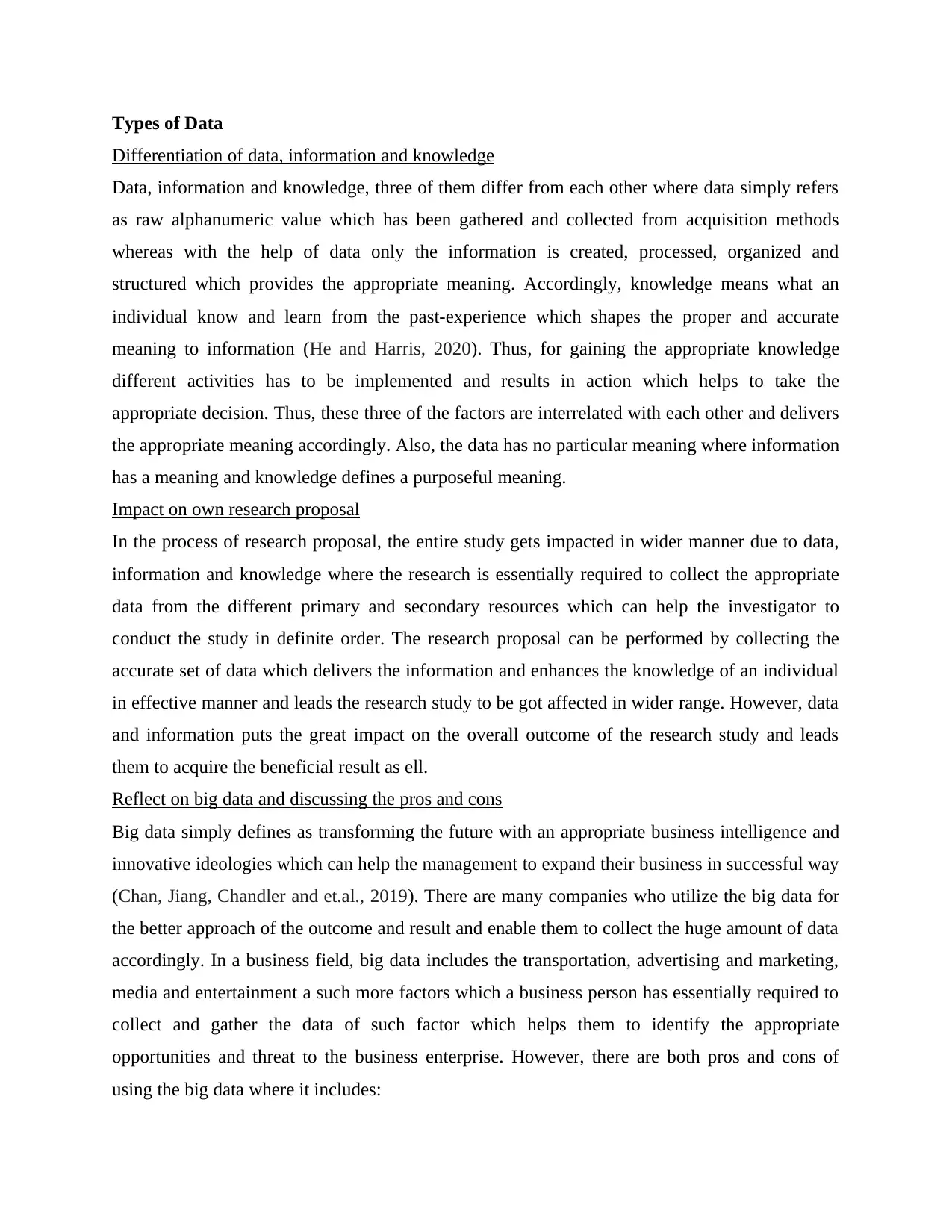
Types of Data
Differentiation of data, information and knowledge
Data, information and knowledge, three of them differ from each other where data simply refers
as raw alphanumeric value which has been gathered and collected from acquisition methods
whereas with the help of data only the information is created, processed, organized and
structured which provides the appropriate meaning. Accordingly, knowledge means what an
individual know and learn from the past-experience which shapes the proper and accurate
meaning to information (He and Harris, 2020). Thus, for gaining the appropriate knowledge
different activities has to be implemented and results in action which helps to take the
appropriate decision. Thus, these three of the factors are interrelated with each other and delivers
the appropriate meaning accordingly. Also, the data has no particular meaning where information
has a meaning and knowledge defines a purposeful meaning.
Impact on own research proposal
In the process of research proposal, the entire study gets impacted in wider manner due to data,
information and knowledge where the research is essentially required to collect the appropriate
data from the different primary and secondary resources which can help the investigator to
conduct the study in definite order. The research proposal can be performed by collecting the
accurate set of data which delivers the information and enhances the knowledge of an individual
in effective manner and leads the research study to be got affected in wider range. However, data
and information puts the great impact on the overall outcome of the research study and leads
them to acquire the beneficial result as ell.
Reflect on big data and discussing the pros and cons
Big data simply defines as transforming the future with an appropriate business intelligence and
innovative ideologies which can help the management to expand their business in successful way
(Chan, Jiang, Chandler and et.al., 2019). There are many companies who utilize the big data for
the better approach of the outcome and result and enable them to collect the huge amount of data
accordingly. In a business field, big data includes the transportation, advertising and marketing,
media and entertainment a such more factors which a business person has essentially required to
collect and gather the data of such factor which helps them to identify the appropriate
opportunities and threat to the business enterprise. However, there are both pros and cons of
using the big data where it includes:
Differentiation of data, information and knowledge
Data, information and knowledge, three of them differ from each other where data simply refers
as raw alphanumeric value which has been gathered and collected from acquisition methods
whereas with the help of data only the information is created, processed, organized and
structured which provides the appropriate meaning. Accordingly, knowledge means what an
individual know and learn from the past-experience which shapes the proper and accurate
meaning to information (He and Harris, 2020). Thus, for gaining the appropriate knowledge
different activities has to be implemented and results in action which helps to take the
appropriate decision. Thus, these three of the factors are interrelated with each other and delivers
the appropriate meaning accordingly. Also, the data has no particular meaning where information
has a meaning and knowledge defines a purposeful meaning.
Impact on own research proposal
In the process of research proposal, the entire study gets impacted in wider manner due to data,
information and knowledge where the research is essentially required to collect the appropriate
data from the different primary and secondary resources which can help the investigator to
conduct the study in definite order. The research proposal can be performed by collecting the
accurate set of data which delivers the information and enhances the knowledge of an individual
in effective manner and leads the research study to be got affected in wider range. However, data
and information puts the great impact on the overall outcome of the research study and leads
them to acquire the beneficial result as ell.
Reflect on big data and discussing the pros and cons
Big data simply defines as transforming the future with an appropriate business intelligence and
innovative ideologies which can help the management to expand their business in successful way
(Chan, Jiang, Chandler and et.al., 2019). There are many companies who utilize the big data for
the better approach of the outcome and result and enable them to collect the huge amount of data
accordingly. In a business field, big data includes the transportation, advertising and marketing,
media and entertainment a such more factors which a business person has essentially required to
collect and gather the data of such factor which helps them to identify the appropriate
opportunities and threat to the business enterprise. However, there are both pros and cons of
using the big data where it includes:
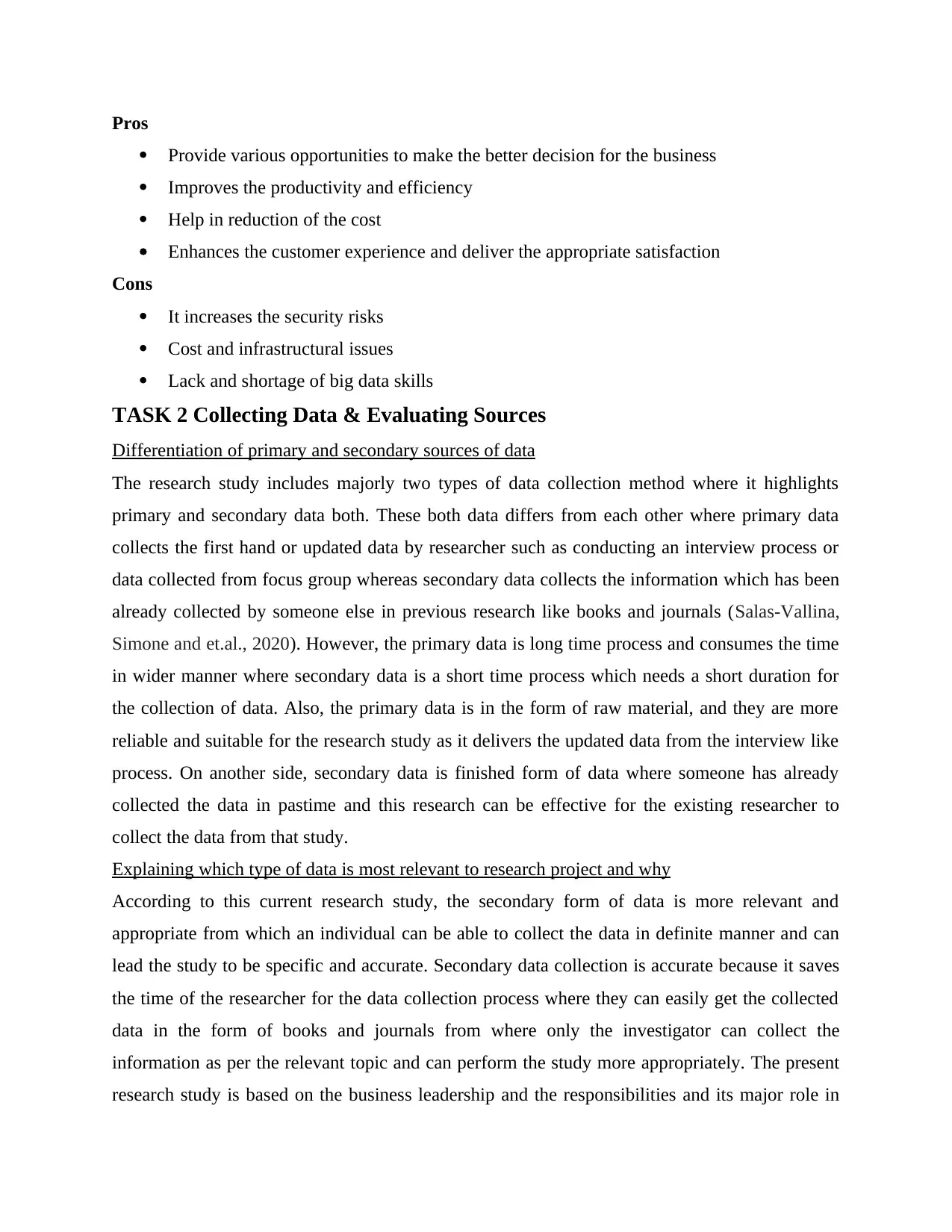
Pros
Provide various opportunities to make the better decision for the business
Improves the productivity and efficiency
Help in reduction of the cost
Enhances the customer experience and deliver the appropriate satisfaction
Cons
It increases the security risks
Cost and infrastructural issues
Lack and shortage of big data skills
TASK 2 Collecting Data & Evaluating Sources
Differentiation of primary and secondary sources of data
The research study includes majorly two types of data collection method where it highlights
primary and secondary data both. These both data differs from each other where primary data
collects the first hand or updated data by researcher such as conducting an interview process or
data collected from focus group whereas secondary data collects the information which has been
already collected by someone else in previous research like books and journals (Salas-Vallina,
Simone and et.al., 2020). However, the primary data is long time process and consumes the time
in wider manner where secondary data is a short time process which needs a short duration for
the collection of data. Also, the primary data is in the form of raw material, and they are more
reliable and suitable for the research study as it delivers the updated data from the interview like
process. On another side, secondary data is finished form of data where someone has already
collected the data in pastime and this research can be effective for the existing researcher to
collect the data from that study.
Explaining which type of data is most relevant to research project and why
According to this current research study, the secondary form of data is more relevant and
appropriate from which an individual can be able to collect the data in definite manner and can
lead the study to be specific and accurate. Secondary data collection is accurate because it saves
the time of the researcher for the data collection process where they can easily get the collected
data in the form of books and journals from where only the investigator can collect the
information as per the relevant topic and can perform the study more appropriately. The present
research study is based on the business leadership and the responsibilities and its major role in
Provide various opportunities to make the better decision for the business
Improves the productivity and efficiency
Help in reduction of the cost
Enhances the customer experience and deliver the appropriate satisfaction
Cons
It increases the security risks
Cost and infrastructural issues
Lack and shortage of big data skills
TASK 2 Collecting Data & Evaluating Sources
Differentiation of primary and secondary sources of data
The research study includes majorly two types of data collection method where it highlights
primary and secondary data both. These both data differs from each other where primary data
collects the first hand or updated data by researcher such as conducting an interview process or
data collected from focus group whereas secondary data collects the information which has been
already collected by someone else in previous research like books and journals (Salas-Vallina,
Simone and et.al., 2020). However, the primary data is long time process and consumes the time
in wider manner where secondary data is a short time process which needs a short duration for
the collection of data. Also, the primary data is in the form of raw material, and they are more
reliable and suitable for the research study as it delivers the updated data from the interview like
process. On another side, secondary data is finished form of data where someone has already
collected the data in pastime and this research can be effective for the existing researcher to
collect the data from that study.
Explaining which type of data is most relevant to research project and why
According to this current research study, the secondary form of data is more relevant and
appropriate from which an individual can be able to collect the data in definite manner and can
lead the study to be specific and accurate. Secondary data collection is accurate because it saves
the time of the researcher for the data collection process where they can easily get the collected
data in the form of books and journals from where only the investigator can collect the
information as per the relevant topic and can perform the study more appropriately. The present
research study is based on the business leadership and the responsibilities and its major role in
⊘ This is a preview!⊘
Do you want full access?
Subscribe today to unlock all pages.

Trusted by 1+ million students worldwide
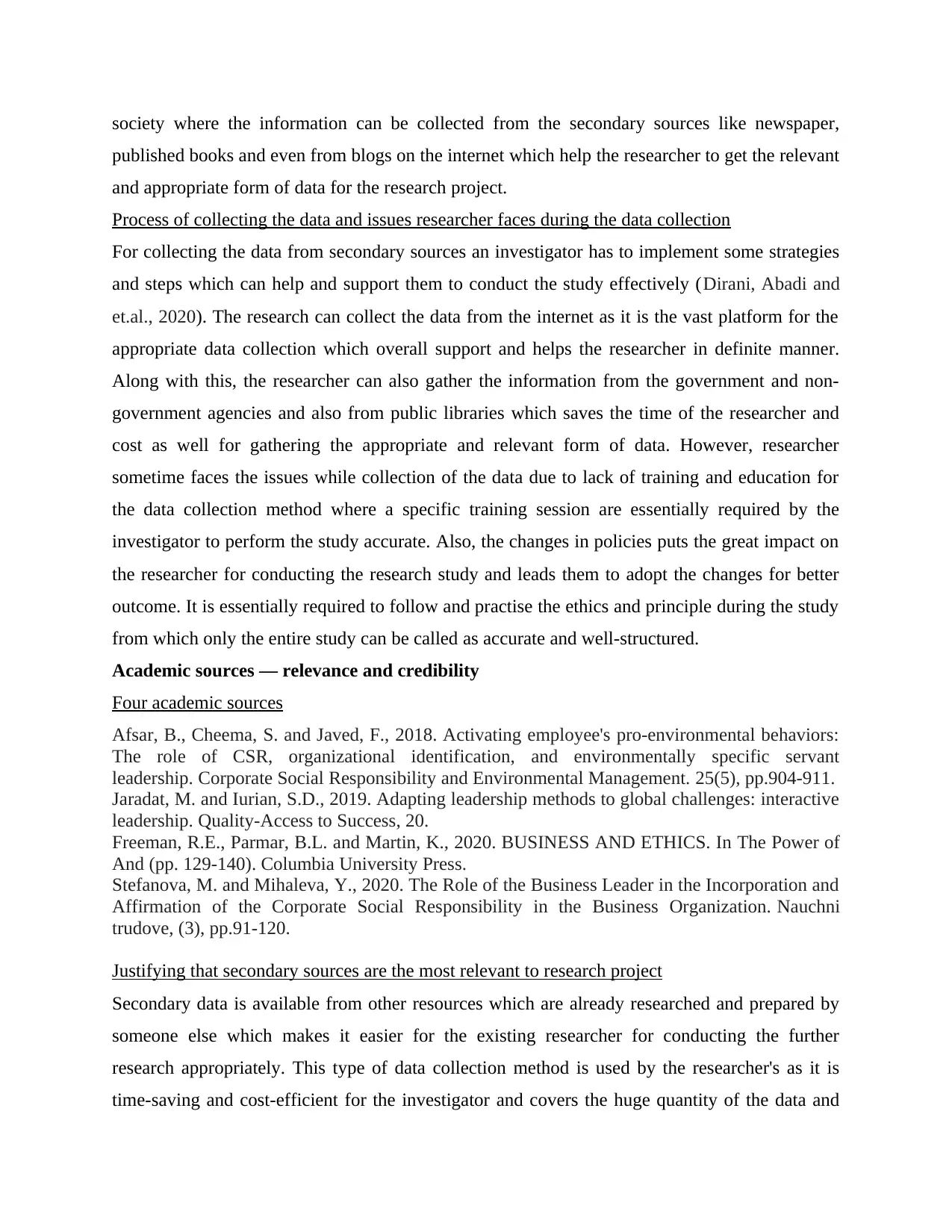
society where the information can be collected from the secondary sources like newspaper,
published books and even from blogs on the internet which help the researcher to get the relevant
and appropriate form of data for the research project.
Process of collecting the data and issues researcher faces during the data collection
For collecting the data from secondary sources an investigator has to implement some strategies
and steps which can help and support them to conduct the study effectively (Dirani, Abadi and
et.al., 2020). The research can collect the data from the internet as it is the vast platform for the
appropriate data collection which overall support and helps the researcher in definite manner.
Along with this, the researcher can also gather the information from the government and non-
government agencies and also from public libraries which saves the time of the researcher and
cost as well for gathering the appropriate and relevant form of data. However, researcher
sometime faces the issues while collection of the data due to lack of training and education for
the data collection method where a specific training session are essentially required by the
investigator to perform the study accurate. Also, the changes in policies puts the great impact on
the researcher for conducting the research study and leads them to adopt the changes for better
outcome. It is essentially required to follow and practise the ethics and principle during the study
from which only the entire study can be called as accurate and well-structured.
Academic sources — relevance and credibility
Four academic sources
Afsar, B., Cheema, S. and Javed, F., 2018. Activating employee's pro‐environmental behaviors:
The role of CSR, organizational identification, and environmentally specific servant
leadership. Corporate Social Responsibility and Environmental Management. 25(5), pp.904-911.
Jaradat, M. and Iurian, S.D., 2019. Adapting leadership methods to global challenges: interactive
leadership. Quality-Access to Success, 20.
Freeman, R.E., Parmar, B.L. and Martin, K., 2020. BUSINESS AND ETHICS. In The Power of
And (pp. 129-140). Columbia University Press.
Stefanova, M. and Mihaleva, Y., 2020. The Role of the Business Leader in the Incorporation and
Affirmation of the Corporate Social Responsibility in the Business Organization. Nauchni
trudove, (3), pp.91-120.
Justifying that secondary sources are the most relevant to research project
Secondary data is available from other resources which are already researched and prepared by
someone else which makes it easier for the existing researcher for conducting the further
research appropriately. This type of data collection method is used by the researcher's as it is
time-saving and cost-efficient for the investigator and covers the huge quantity of the data and
published books and even from blogs on the internet which help the researcher to get the relevant
and appropriate form of data for the research project.
Process of collecting the data and issues researcher faces during the data collection
For collecting the data from secondary sources an investigator has to implement some strategies
and steps which can help and support them to conduct the study effectively (Dirani, Abadi and
et.al., 2020). The research can collect the data from the internet as it is the vast platform for the
appropriate data collection which overall support and helps the researcher in definite manner.
Along with this, the researcher can also gather the information from the government and non-
government agencies and also from public libraries which saves the time of the researcher and
cost as well for gathering the appropriate and relevant form of data. However, researcher
sometime faces the issues while collection of the data due to lack of training and education for
the data collection method where a specific training session are essentially required by the
investigator to perform the study accurate. Also, the changes in policies puts the great impact on
the researcher for conducting the research study and leads them to adopt the changes for better
outcome. It is essentially required to follow and practise the ethics and principle during the study
from which only the entire study can be called as accurate and well-structured.
Academic sources — relevance and credibility
Four academic sources
Afsar, B., Cheema, S. and Javed, F., 2018. Activating employee's pro‐environmental behaviors:
The role of CSR, organizational identification, and environmentally specific servant
leadership. Corporate Social Responsibility and Environmental Management. 25(5), pp.904-911.
Jaradat, M. and Iurian, S.D., 2019. Adapting leadership methods to global challenges: interactive
leadership. Quality-Access to Success, 20.
Freeman, R.E., Parmar, B.L. and Martin, K., 2020. BUSINESS AND ETHICS. In The Power of
And (pp. 129-140). Columbia University Press.
Stefanova, M. and Mihaleva, Y., 2020. The Role of the Business Leader in the Incorporation and
Affirmation of the Corporate Social Responsibility in the Business Organization. Nauchni
trudove, (3), pp.91-120.
Justifying that secondary sources are the most relevant to research project
Secondary data is available from other resources which are already researched and prepared by
someone else which makes it easier for the existing researcher for conducting the further
research appropriately. This type of data collection method is used by the researcher's as it is
time-saving and cost-efficient for the investigator and covers the huge quantity of the data and
Paraphrase This Document
Need a fresh take? Get an instant paraphrase of this document with our AI Paraphraser
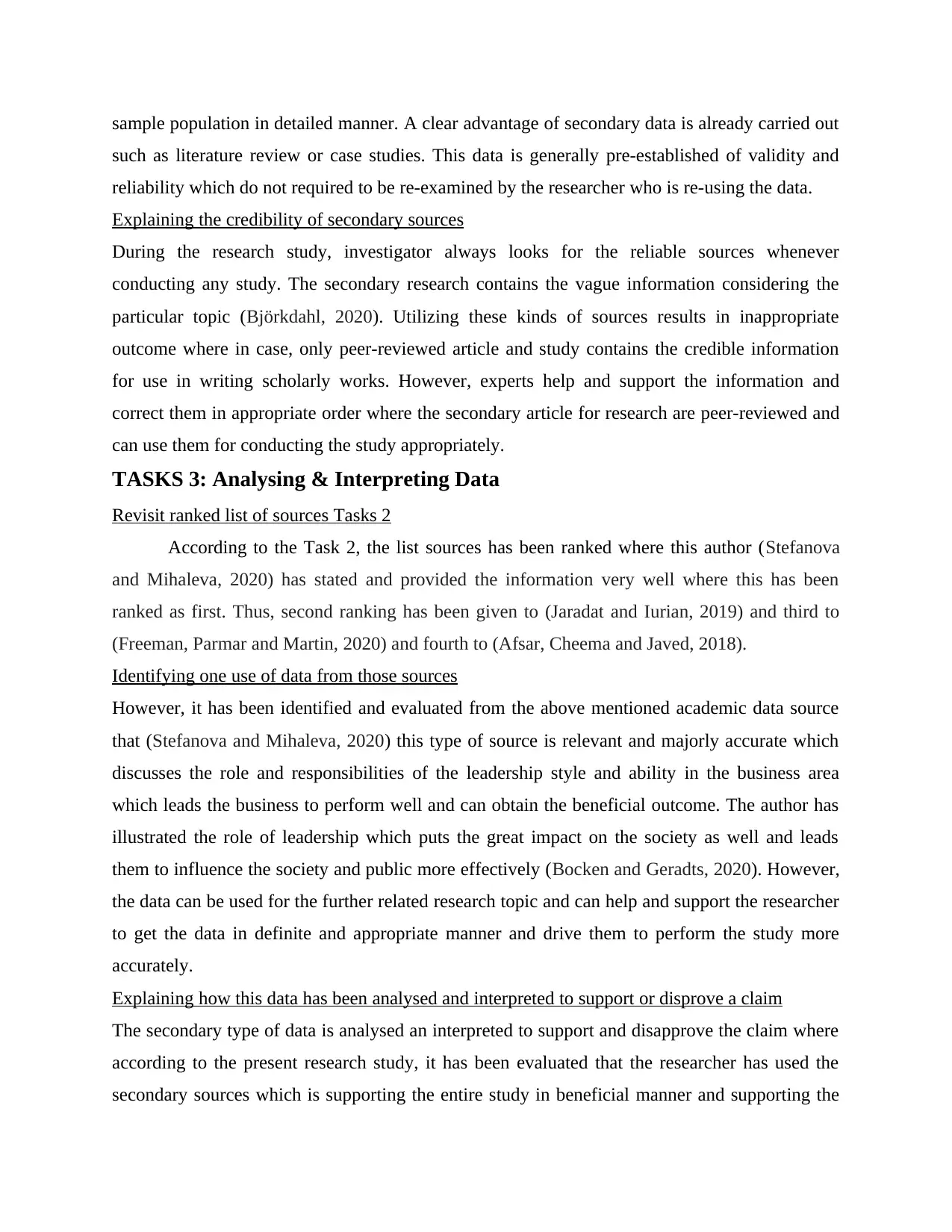
sample population in detailed manner. A clear advantage of secondary data is already carried out
such as literature review or case studies. This data is generally pre-established of validity and
reliability which do not required to be re-examined by the researcher who is re-using the data.
Explaining the credibility of secondary sources
During the research study, investigator always looks for the reliable sources whenever
conducting any study. The secondary research contains the vague information considering the
particular topic (Björkdahl, 2020). Utilizing these kinds of sources results in inappropriate
outcome where in case, only peer-reviewed article and study contains the credible information
for use in writing scholarly works. However, experts help and support the information and
correct them in appropriate order where the secondary article for research are peer-reviewed and
can use them for conducting the study appropriately.
TASKS 3: Analysing & Interpreting Data
Revisit ranked list of sources Tasks 2
According to the Task 2, the list sources has been ranked where this author (Stefanova
and Mihaleva, 2020) has stated and provided the information very well where this has been
ranked as first. Thus, second ranking has been given to (Jaradat and Iurian, 2019) and third to
(Freeman, Parmar and Martin, 2020) and fourth to (Afsar, Cheema and Javed, 2018).
Identifying one use of data from those sources
However, it has been identified and evaluated from the above mentioned academic data source
that (Stefanova and Mihaleva, 2020) this type of source is relevant and majorly accurate which
discusses the role and responsibilities of the leadership style and ability in the business area
which leads the business to perform well and can obtain the beneficial outcome. The author has
illustrated the role of leadership which puts the great impact on the society as well and leads
them to influence the society and public more effectively (Bocken and Geradts, 2020). However,
the data can be used for the further related research topic and can help and support the researcher
to get the data in definite and appropriate manner and drive them to perform the study more
accurately.
Explaining how this data has been analysed and interpreted to support or disprove a claim
The secondary type of data is analysed an interpreted to support and disapprove the claim where
according to the present research study, it has been evaluated that the researcher has used the
secondary sources which is supporting the entire study in beneficial manner and supporting the
such as literature review or case studies. This data is generally pre-established of validity and
reliability which do not required to be re-examined by the researcher who is re-using the data.
Explaining the credibility of secondary sources
During the research study, investigator always looks for the reliable sources whenever
conducting any study. The secondary research contains the vague information considering the
particular topic (Björkdahl, 2020). Utilizing these kinds of sources results in inappropriate
outcome where in case, only peer-reviewed article and study contains the credible information
for use in writing scholarly works. However, experts help and support the information and
correct them in appropriate order where the secondary article for research are peer-reviewed and
can use them for conducting the study appropriately.
TASKS 3: Analysing & Interpreting Data
Revisit ranked list of sources Tasks 2
According to the Task 2, the list sources has been ranked where this author (Stefanova
and Mihaleva, 2020) has stated and provided the information very well where this has been
ranked as first. Thus, second ranking has been given to (Jaradat and Iurian, 2019) and third to
(Freeman, Parmar and Martin, 2020) and fourth to (Afsar, Cheema and Javed, 2018).
Identifying one use of data from those sources
However, it has been identified and evaluated from the above mentioned academic data source
that (Stefanova and Mihaleva, 2020) this type of source is relevant and majorly accurate which
discusses the role and responsibilities of the leadership style and ability in the business area
which leads the business to perform well and can obtain the beneficial outcome. The author has
illustrated the role of leadership which puts the great impact on the society as well and leads
them to influence the society and public more effectively (Bocken and Geradts, 2020). However,
the data can be used for the further related research topic and can help and support the researcher
to get the data in definite and appropriate manner and drive them to perform the study more
accurately.
Explaining how this data has been analysed and interpreted to support or disprove a claim
The secondary type of data is analysed an interpreted to support and disapprove the claim where
according to the present research study, it has been evaluated that the researcher has used the
secondary sources which is supporting the entire study in beneficial manner and supporting the
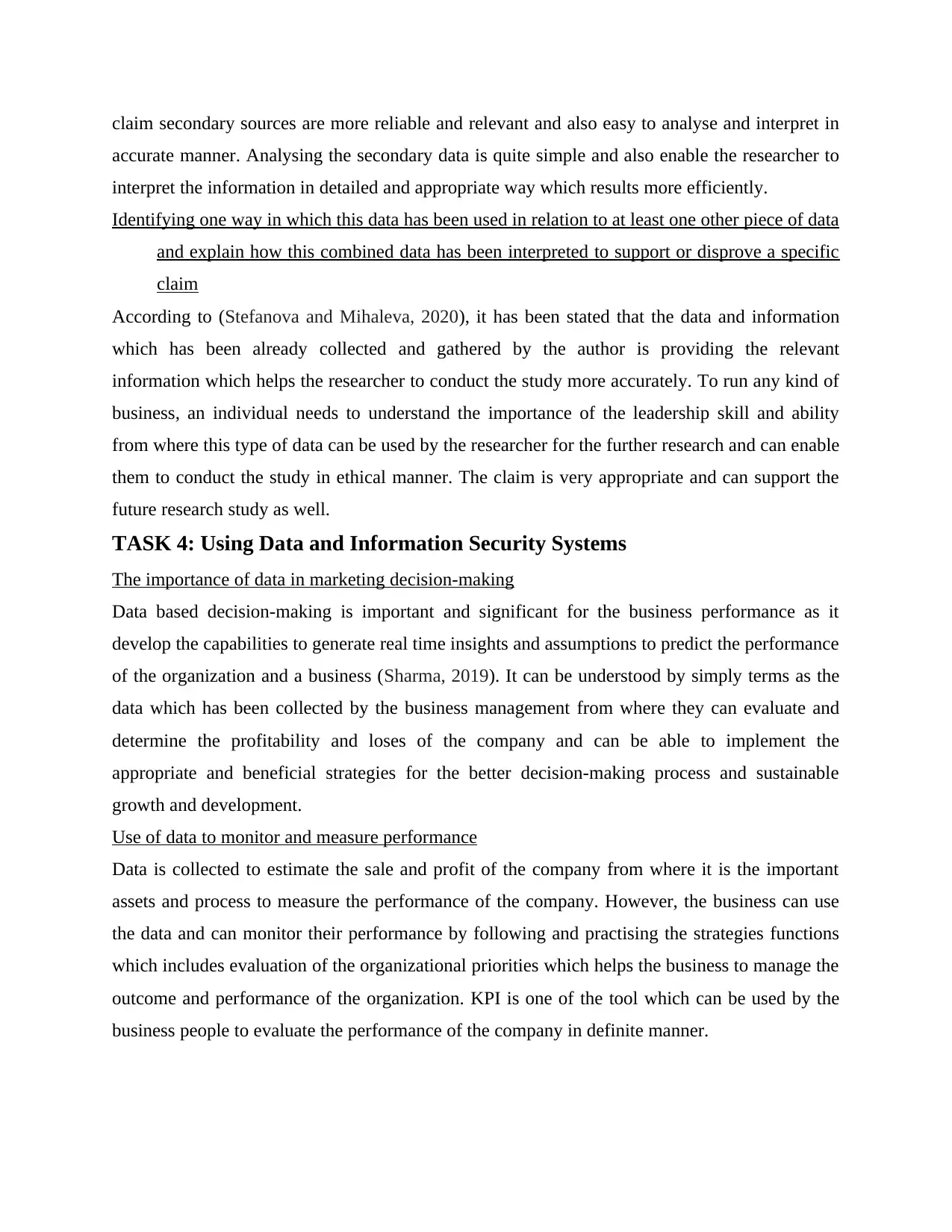
claim secondary sources are more reliable and relevant and also easy to analyse and interpret in
accurate manner. Analysing the secondary data is quite simple and also enable the researcher to
interpret the information in detailed and appropriate way which results more efficiently.
Identifying one way in which this data has been used in relation to at least one other piece of data
and explain how this combined data has been interpreted to support or disprove a specific
claim
According to (Stefanova and Mihaleva, 2020), it has been stated that the data and information
which has been already collected and gathered by the author is providing the relevant
information which helps the researcher to conduct the study more accurately. To run any kind of
business, an individual needs to understand the importance of the leadership skill and ability
from where this type of data can be used by the researcher for the further research and can enable
them to conduct the study in ethical manner. The claim is very appropriate and can support the
future research study as well.
TASK 4: Using Data and Information Security Systems
The importance of data in marketing decision-making
Data based decision-making is important and significant for the business performance as it
develop the capabilities to generate real time insights and assumptions to predict the performance
of the organization and a business (Sharma, 2019). It can be understood by simply terms as the
data which has been collected by the business management from where they can evaluate and
determine the profitability and loses of the company and can be able to implement the
appropriate and beneficial strategies for the better decision-making process and sustainable
growth and development.
Use of data to monitor and measure performance
Data is collected to estimate the sale and profit of the company from where it is the important
assets and process to measure the performance of the company. However, the business can use
the data and can monitor their performance by following and practising the strategies functions
which includes evaluation of the organizational priorities which helps the business to manage the
outcome and performance of the organization. KPI is one of the tool which can be used by the
business people to evaluate the performance of the company in definite manner.
accurate manner. Analysing the secondary data is quite simple and also enable the researcher to
interpret the information in detailed and appropriate way which results more efficiently.
Identifying one way in which this data has been used in relation to at least one other piece of data
and explain how this combined data has been interpreted to support or disprove a specific
claim
According to (Stefanova and Mihaleva, 2020), it has been stated that the data and information
which has been already collected and gathered by the author is providing the relevant
information which helps the researcher to conduct the study more accurately. To run any kind of
business, an individual needs to understand the importance of the leadership skill and ability
from where this type of data can be used by the researcher for the further research and can enable
them to conduct the study in ethical manner. The claim is very appropriate and can support the
future research study as well.
TASK 4: Using Data and Information Security Systems
The importance of data in marketing decision-making
Data based decision-making is important and significant for the business performance as it
develop the capabilities to generate real time insights and assumptions to predict the performance
of the organization and a business (Sharma, 2019). It can be understood by simply terms as the
data which has been collected by the business management from where they can evaluate and
determine the profitability and loses of the company and can be able to implement the
appropriate and beneficial strategies for the better decision-making process and sustainable
growth and development.
Use of data to monitor and measure performance
Data is collected to estimate the sale and profit of the company from where it is the important
assets and process to measure the performance of the company. However, the business can use
the data and can monitor their performance by following and practising the strategies functions
which includes evaluation of the organizational priorities which helps the business to manage the
outcome and performance of the organization. KPI is one of the tool which can be used by the
business people to evaluate the performance of the company in definite manner.
⊘ This is a preview!⊘
Do you want full access?
Subscribe today to unlock all pages.

Trusted by 1+ million students worldwide
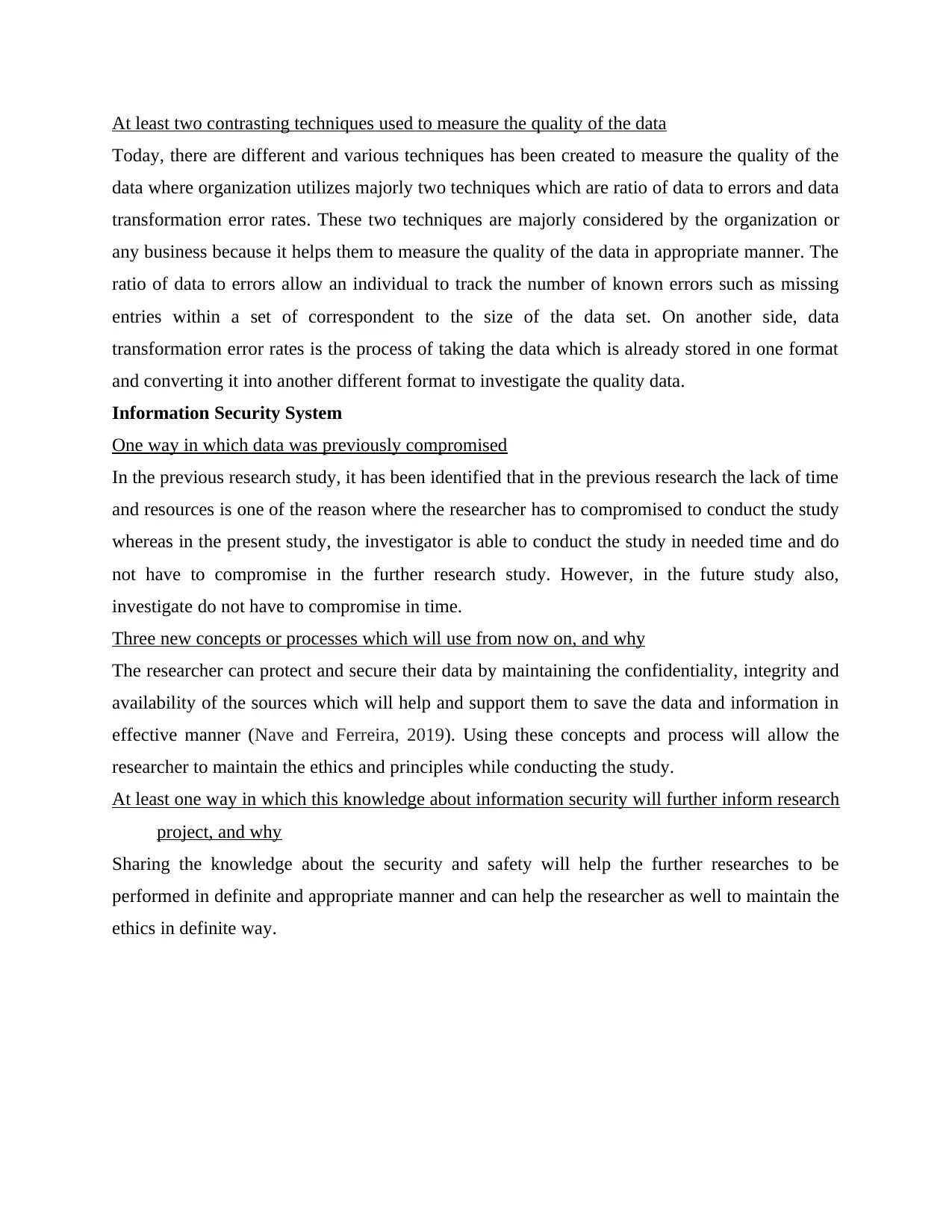
At least two contrasting techniques used to measure the quality of the data
Today, there are different and various techniques has been created to measure the quality of the
data where organization utilizes majorly two techniques which are ratio of data to errors and data
transformation error rates. These two techniques are majorly considered by the organization or
any business because it helps them to measure the quality of the data in appropriate manner. The
ratio of data to errors allow an individual to track the number of known errors such as missing
entries within a set of correspondent to the size of the data set. On another side, data
transformation error rates is the process of taking the data which is already stored in one format
and converting it into another different format to investigate the quality data.
Information Security System
One way in which data was previously compromised
In the previous research study, it has been identified that in the previous research the lack of time
and resources is one of the reason where the researcher has to compromised to conduct the study
whereas in the present study, the investigator is able to conduct the study in needed time and do
not have to compromise in the further research study. However, in the future study also,
investigate do not have to compromise in time.
Three new concepts or processes which will use from now on, and why
The researcher can protect and secure their data by maintaining the confidentiality, integrity and
availability of the sources which will help and support them to save the data and information in
effective manner (Nave and Ferreira, 2019). Using these concepts and process will allow the
researcher to maintain the ethics and principles while conducting the study.
At least one way in which this knowledge about information security will further inform research
project, and why
Sharing the knowledge about the security and safety will help the further researches to be
performed in definite and appropriate manner and can help the researcher as well to maintain the
ethics in definite way.
Today, there are different and various techniques has been created to measure the quality of the
data where organization utilizes majorly two techniques which are ratio of data to errors and data
transformation error rates. These two techniques are majorly considered by the organization or
any business because it helps them to measure the quality of the data in appropriate manner. The
ratio of data to errors allow an individual to track the number of known errors such as missing
entries within a set of correspondent to the size of the data set. On another side, data
transformation error rates is the process of taking the data which is already stored in one format
and converting it into another different format to investigate the quality data.
Information Security System
One way in which data was previously compromised
In the previous research study, it has been identified that in the previous research the lack of time
and resources is one of the reason where the researcher has to compromised to conduct the study
whereas in the present study, the investigator is able to conduct the study in needed time and do
not have to compromise in the further research study. However, in the future study also,
investigate do not have to compromise in time.
Three new concepts or processes which will use from now on, and why
The researcher can protect and secure their data by maintaining the confidentiality, integrity and
availability of the sources which will help and support them to save the data and information in
effective manner (Nave and Ferreira, 2019). Using these concepts and process will allow the
researcher to maintain the ethics and principles while conducting the study.
At least one way in which this knowledge about information security will further inform research
project, and why
Sharing the knowledge about the security and safety will help the further researches to be
performed in definite and appropriate manner and can help the researcher as well to maintain the
ethics in definite way.
Paraphrase This Document
Need a fresh take? Get an instant paraphrase of this document with our AI Paraphraser
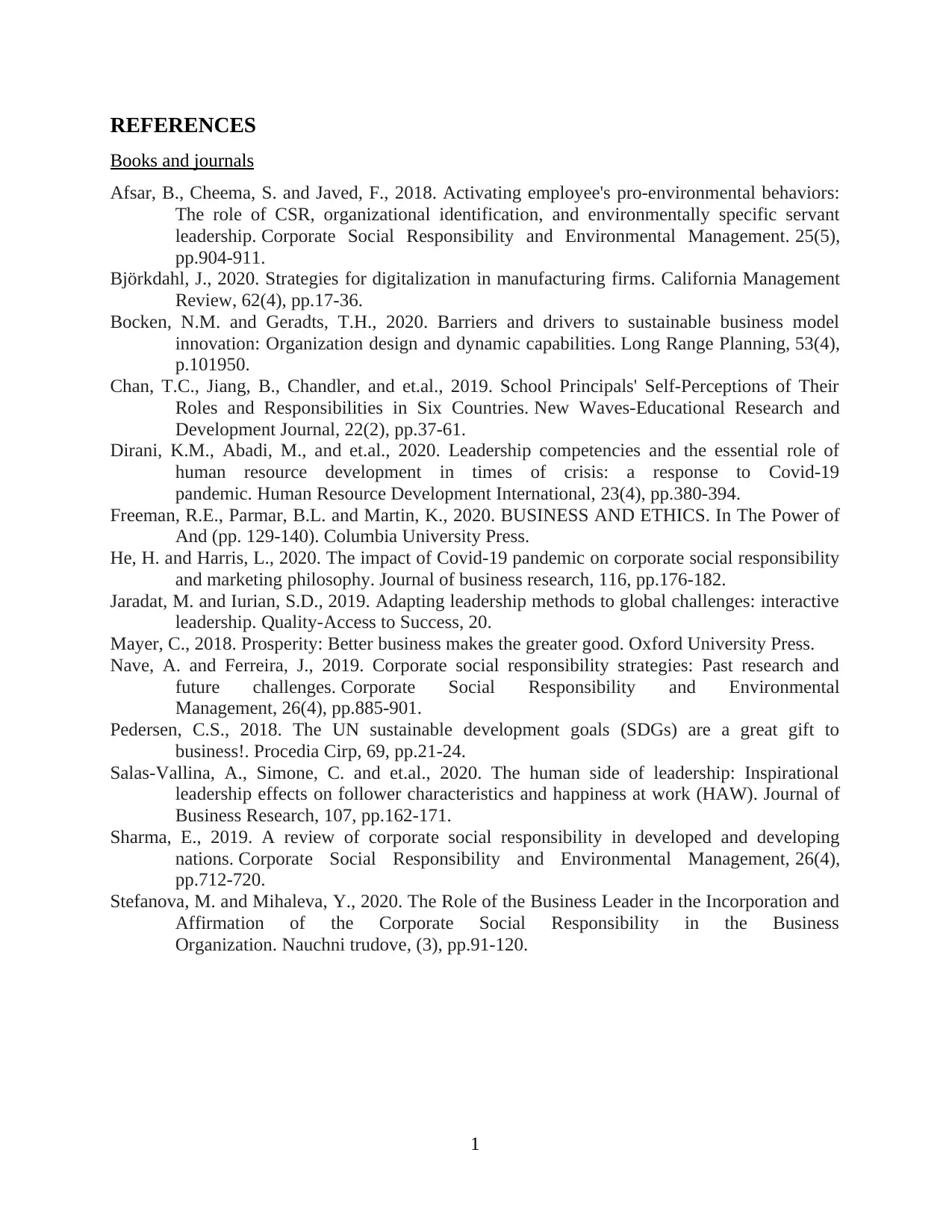
REFERENCES
Books and journals
Afsar, B., Cheema, S. and Javed, F., 2018. Activating employee's pro‐environmental behaviors:
The role of CSR, organizational identification, and environmentally specific servant
leadership. Corporate Social Responsibility and Environmental Management. 25(5),
pp.904-911.
Björkdahl, J., 2020. Strategies for digitalization in manufacturing firms. California Management
Review, 62(4), pp.17-36.
Bocken, N.M. and Geradts, T.H., 2020. Barriers and drivers to sustainable business model
innovation: Organization design and dynamic capabilities. Long Range Planning, 53(4),
p.101950.
Chan, T.C., Jiang, B., Chandler, and et.al., 2019. School Principals' Self-Perceptions of Their
Roles and Responsibilities in Six Countries. New Waves-Educational Research and
Development Journal, 22(2), pp.37-61.
Dirani, K.M., Abadi, M., and et.al., 2020. Leadership competencies and the essential role of
human resource development in times of crisis: a response to Covid-19
pandemic. Human Resource Development International, 23(4), pp.380-394.
Freeman, R.E., Parmar, B.L. and Martin, K., 2020. BUSINESS AND ETHICS. In The Power of
And (pp. 129-140). Columbia University Press.
He, H. and Harris, L., 2020. The impact of Covid-19 pandemic on corporate social responsibility
and marketing philosophy. Journal of business research, 116, pp.176-182.
Jaradat, M. and Iurian, S.D., 2019. Adapting leadership methods to global challenges: interactive
leadership. Quality-Access to Success, 20.
Mayer, C., 2018. Prosperity: Better business makes the greater good. Oxford University Press.
Nave, A. and Ferreira, J., 2019. Corporate social responsibility strategies: Past research and
future challenges. Corporate Social Responsibility and Environmental
Management, 26(4), pp.885-901.
Pedersen, C.S., 2018. The UN sustainable development goals (SDGs) are a great gift to
business!. Procedia Cirp, 69, pp.21-24.
Salas-Vallina, A., Simone, C. and et.al., 2020. The human side of leadership: Inspirational
leadership effects on follower characteristics and happiness at work (HAW). Journal of
Business Research, 107, pp.162-171.
Sharma, E., 2019. A review of corporate social responsibility in developed and developing
nations. Corporate Social Responsibility and Environmental Management, 26(4),
pp.712-720.
Stefanova, M. and Mihaleva, Y., 2020. The Role of the Business Leader in the Incorporation and
Affirmation of the Corporate Social Responsibility in the Business
Organization. Nauchni trudove, (3), pp.91-120.
1
Books and journals
Afsar, B., Cheema, S. and Javed, F., 2018. Activating employee's pro‐environmental behaviors:
The role of CSR, organizational identification, and environmentally specific servant
leadership. Corporate Social Responsibility and Environmental Management. 25(5),
pp.904-911.
Björkdahl, J., 2020. Strategies for digitalization in manufacturing firms. California Management
Review, 62(4), pp.17-36.
Bocken, N.M. and Geradts, T.H., 2020. Barriers and drivers to sustainable business model
innovation: Organization design and dynamic capabilities. Long Range Planning, 53(4),
p.101950.
Chan, T.C., Jiang, B., Chandler, and et.al., 2019. School Principals' Self-Perceptions of Their
Roles and Responsibilities in Six Countries. New Waves-Educational Research and
Development Journal, 22(2), pp.37-61.
Dirani, K.M., Abadi, M., and et.al., 2020. Leadership competencies and the essential role of
human resource development in times of crisis: a response to Covid-19
pandemic. Human Resource Development International, 23(4), pp.380-394.
Freeman, R.E., Parmar, B.L. and Martin, K., 2020. BUSINESS AND ETHICS. In The Power of
And (pp. 129-140). Columbia University Press.
He, H. and Harris, L., 2020. The impact of Covid-19 pandemic on corporate social responsibility
and marketing philosophy. Journal of business research, 116, pp.176-182.
Jaradat, M. and Iurian, S.D., 2019. Adapting leadership methods to global challenges: interactive
leadership. Quality-Access to Success, 20.
Mayer, C., 2018. Prosperity: Better business makes the greater good. Oxford University Press.
Nave, A. and Ferreira, J., 2019. Corporate social responsibility strategies: Past research and
future challenges. Corporate Social Responsibility and Environmental
Management, 26(4), pp.885-901.
Pedersen, C.S., 2018. The UN sustainable development goals (SDGs) are a great gift to
business!. Procedia Cirp, 69, pp.21-24.
Salas-Vallina, A., Simone, C. and et.al., 2020. The human side of leadership: Inspirational
leadership effects on follower characteristics and happiness at work (HAW). Journal of
Business Research, 107, pp.162-171.
Sharma, E., 2019. A review of corporate social responsibility in developed and developing
nations. Corporate Social Responsibility and Environmental Management, 26(4),
pp.712-720.
Stefanova, M. and Mihaleva, Y., 2020. The Role of the Business Leader in the Incorporation and
Affirmation of the Corporate Social Responsibility in the Business
Organization. Nauchni trudove, (3), pp.91-120.
1
1 out of 11
Related Documents
Your All-in-One AI-Powered Toolkit for Academic Success.
+13062052269
info@desklib.com
Available 24*7 on WhatsApp / Email
![[object Object]](/_next/static/media/star-bottom.7253800d.svg)
Unlock your academic potential
Copyright © 2020–2025 A2Z Services. All Rights Reserved. Developed and managed by ZUCOL.





